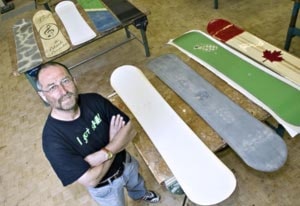Forget about birdhouses or wobbly-legged chairs — FH Collins students have moved on to building bigger, better and hipper, things.
Gerry Quarton’s Wood Products Grade 11/12 class, as it’s officially known, gives students a chance to build a professional quality snowboard, and understand the process behind the product.
After three years, students are jumping at the chance to enroll.
“I’m packed to the gills for both terms for next year,” said Quarton, who had all this year’s boards laid out on the shop tables, graded and ready for students to take home.
“I usually don’t get a lot of academic students, but this has wide appeal,” said Quarton, who also teaches more traditional industrial arts classes, like cabinetmaking or residential construction.
“This generates a real cross-section of students, we’ve got a lot of girls, and the Grade 8 kids are getting keen to do it.”
For a $100 materials fee, students get to use the same tools, materials and techniques the pros use, earn school credit and take their one-of-a-kind snowboard home with them.
Quarton got the idea while trying to get his sons interested in shop.
Seeing parallels between his own education in furniture design and modern skateboard and snowboard design, he decided to figure it out, starting with skateboards.
“It’s all principles of wood-bending,” he said.
Quarton admits he’s learning as he goes along, keeping “one step ahead of the kids,” he said.
Several layers of thin wood are pressed together with a form, and put into a vacuum bag — that’s how a skateboard gets it’s concave shape.
A snowboard is a bit more complex and the materials are much harder to come by. “You don’t get this stuff at Home Hardware,” he said, pulling out long rectangular sheets of birch laminate, with pre cut binding holes.
The p-tex bottom layer, metal edges, fiberglass and mystery top layer (a plastic that binds with fiberglass) are all special ordered from Europe or the US, the same suppliers the commercial hand builders buy from.
The student designs the shape, assembles the layers in a metal form, then the board is “cooked” in the vacuum bag, and will hold its shape.
“I know that only three schools in Canada are doing this,” said Quarton. “One in North York, one in Alberta, and us.”
After three years, Quarton thinks the process is coming together, and the kids are learning valuable lessons.
“90 per cent of the population doesn’t know what goes into these boards, some of the best riders in the world don’t know what these kids know.”
However, he’s never seen one of his student’s boards in action.
“I’d like to make them take their boards to the hill, they don’t believe it will hold up, but don’t kid yourself,” he said.
“I think there’s a bit of reluctance to ride them, because I don’t charge enough,” he said. “They think they’re not as good — they think ‘how can I build something better than Burton?’ They have no concept the capacity is there.”
Once they can put together a decent board, students start thinking about appearances, which brings in elements of graphic design and art, and a slick looking board is what really impresses the other students.
For Quarton, getting kids into the shop is what it’s all about.
“This is a hook that gets them in the door, maybe they’ll come and learn a trade,” he said. “Not that the world needs eight more snowboard builders — it’s just a sense that ‘I can make something really neat, with my own hands.’
“I don’t think we get to do that very often anymore.
Every generation gets more removed from that — I’m not suggesting we go back to that, I mean, this is a pretty state of the art popular culture item,” he said of the snowboards.
“Where do we go from here?” he asked. Looking around his shop. “There’s the chair molds right over there.”
